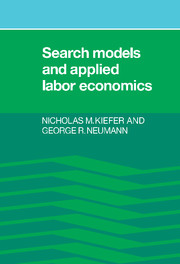Book contents
- Frontmatter
- Contents
- Preface
- 1 Introduction
- Part I Wages, reservation wages, and duration
- Part II Continuous-time models of duration
- 5 Earnings, unemployment, and the allocation of time over time
- 6 Choice or chance? A structural interpretation of individual labor market histories
- 7 Layoffs and duration dependence in a model of turnover
- Part III Applications
- Part IV Mobility and contracting
- Index
7 - Layoffs and duration dependence in a model of turnover
Published online by Cambridge University Press: 06 October 2009
- Frontmatter
- Contents
- Preface
- 1 Introduction
- Part I Wages, reservation wages, and duration
- Part II Continuous-time models of duration
- 5 Earnings, unemployment, and the allocation of time over time
- 6 Choice or chance? A structural interpretation of individual labor market histories
- 7 Layoffs and duration dependence in a model of turnover
- Part III Applications
- Part IV Mobility and contracting
- Index
Summary
Introduction
The purpose of this chapter is to analyze and estimate a model of labor market turnover in which there is duration dependence. To achieve this goal a semi-Markov model of an individual's labor market history is constructed. Preliminary results presented here appear to support the claim that the particular semi-Markov specification derived in this study is preferred to the Markov specification.
Previous work on turnover in the context of behavioral models includes papers by Burdett et al. (1980) and Flinn and Heckman (1982). Recent empirical and theoretical work on turnover in the labor market has often emphasized a Markov model as the base case. The assumptions necessary to generate a Markov process for transitions between labor market states are discussed in Burdett et al. (1984). Heuristically, a Markov model requires conditions that guarantee that the probability an individual changes state depends only on the state currently occupied. Thus, restrictions are imposed which rule out that this individual's previous labor market history plays any role.
The Markov model is a natural extension of previous work done on job search. With job search models, however, only the transition from unemployment to employment is considered. The vast majority of job search models presented to date imply that the transition rate from unemployment does not depend on the duration in that state.
- Type
- Chapter
- Information
- Search Models and Applied Labor Economics , pp. 139 - 160Publisher: Cambridge University PressPrint publication year: 1989



